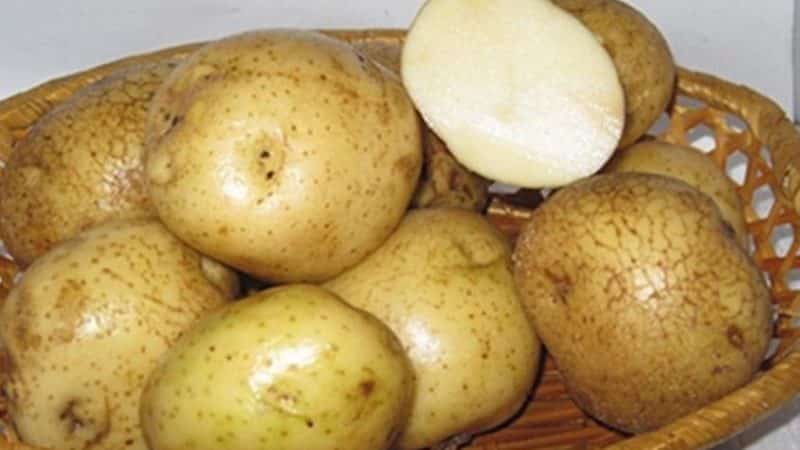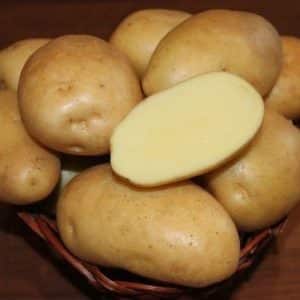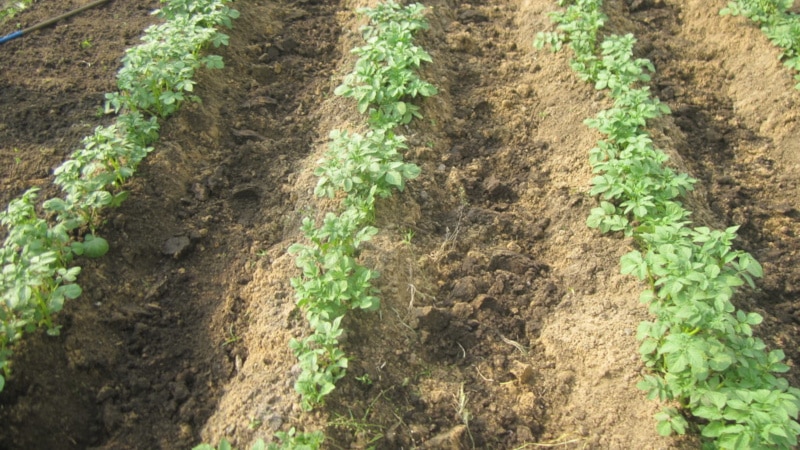Unpretentious, mid-late potato variety “Nikulinsky”
Potatoes are a regular guest on every table, highly valued for their nutritional qualities. Rich in vitamins and microelements, this root vegetable is an indispensable part of the Russian diet. The abundance of varieties existing today provides a choice of root vegetables for every gastronomic taste.
A real pearl of domestic potato farms is the Nikulinsky variety, developed in the early 90s. In the article you will find a description, characteristics, photos and detailed rules for caring for this crop.
Description of the variety
Let us consider in detail the characteristics, properties and composition of this variety.
Origin and development
The Nikulinsky potato variety was bred by employees of the State Scientific Institution All-Russian Research Institute of Potato Farming named after. A.G. Lorha is based on the varieties Mavka and Peresvet, widely known in agriculture. The variety was included in the State Register of the Russian Federation in 1996.

Chemical composition, trace elements and vitamins
Due to its composition, Nikulinsky potatoes are considered the most valuable source of vitamins and microelements for the human body.
Every 100 g of raw tubers contains the following microelements:
- iron 0.9 mg;
- zinc 0.36 mg;
- aluminum 860 mcg;
- rubidium 500 mcg;
- vanadium 149 mcg;
- copper 140 mcg;
- boron 115 mcg;
- lithium 77 mcg;
- fluoride 30 mcg;
- chromium 10 mcg;
- molybdenum 8 mcg;
- nickel 5µg;
- iodine 5 mcg;
- cobalt 5 mcg;
- selenium 0.3 mcg;
- manganese 0.17 mcg.
In addition to a rich set of microelements, 100 g of potatoes includes the following macroelements:
- potassium 568 mg;
- phosphorus 58 mg;
- chlorine 58 mg;
- sulfur 32 mg;
- magnesium 23 mg;
- calcium 10 mg;
- sodium 5 mg.
Vitamin content in 100 g of raw tubers:
- vitamin C 20 mg;
- niacin equivalent (vitamin PP) 1.8 mg;
- vitamin PP 1.3 mg;
- riboflavin (B2) 0.7 mg;
- pantothenic acid (B5) 0.3 mg;
- pyridoxine (B6) 0.3 mg;
- thiamine (B1) 0.13 mg;
- vitamin E (TE) 0.1 mg;
- beta-carotene 0.02 mg;
- folic acid (B9) 8 mcg;
- vitamin A (VE) 3 mcg;
- biotin (vitamin H) 0.1 mcg.
Nutritional value of potatoes of the Nikulinsky variety:
- water 78.6 g;
- carbohydrates 16.3 g;
- starch ((C6H10O5)n) more than 15 g (12-21% by weight);
- proteins 2 g;
- dietary fiber 1.4 g;
- disaccharides and monosaccharides 1.3 g;
- ash 1.1 g;
- fats 0.4 g;
- organic acids 0.2 g;
- saturated fatty acids 0.1 g.
The high starch content allows the tubers to be used for the industrial production of this substance.
Ripening period
Despite the early formation of tubers, Nikulinsky is classified as a mid-late potato variety. Its ripening period is about 120 days (4 months)
Productivity
The State Register classifies the variety as high-yielding. Subject to the basic rules of planting and caring for 10 sq. m you can collect up to 50 kg of root crops. According to the originator, the variety is capable of producing from 170 to 295 kg of yield when harvested from 1 hectare.
Farmers from the Ivanovo region managed to collect a record amount of potatoes, amounting to 410 kg per hectare.
Disease resistance
The variety is characterized by a high degree of resistance to diseases characteristic of the crop, such as:
- black spot (alternaria);
- late blight;
- cancer potatoes;
- Y virus (PVY).
Shows an average degree of resistance to:
- black scab (rhizoctoniosis);
- common scab.
All of the above characteristics make the Nikulinsky variety attractive both for cultivation in private farming and for cultivation for industrial purposes. However, the variety is susceptible to nematode infection and is often attacked by the Colorado potato beetle, which must be kept in mind during its cultivation.
Characteristics of tubers, description of appearance
The weight of one tuber varies between 70-140 g. Root vegetables are oval in shape. The snow-white pulp is covered with a yellowish peel with a mesh pattern. After cleaning it does not darken in air. The eyes are small and almost colorless. Light sprouts have a purple tint at the base. The starch content is high, up to 22%.
Tall bushes - up to 80 cm. The stems are erect, with a large number of lateral branches and leaves. The foliage is dark green, with a characteristic elongated shape with jagged edges. The flowers forming into corollas are colored reddish-purple.
For which regions is it recommended?
Nikulinsky potatoes are quite unpretentious to climatic conditions. However, maximum yield from the crop can be achieved when it is planted on fertile soils. At the same time, weather conditions have virtually no effect on the stability of the variety’s yield.
According to the State Register, the variety is recommended for cultivation in the following regions of the country:
- Northwestern;
- Central;
- Volgo-Vyatsky;
- Middle Volga;
- Ural.
Advantages and disadvantages of the variety
The main advantages of the variety:
- ease of care;
- the ability to successfully grow in almost any type of soil;
- resistance to dangerous diseases;
- resistance to adverse climatic conditions;
- high productivity;
- excellent keeping quality.
The most frequently noted disadvantages are:
- has no genetic protection against pests;
- average (according to some potato connoisseurs) taste qualities.
What is the difference from other varieties
The main difference between Nikulinsky and other popular varieties is its complex resistance to most common potato diseases. In addition, the variety is unpretentious in relation to agrotechnical and climatic growing conditions, which makes it suitable for cultivation in almost all regions of the country.
However, when choosing Nikulinsky as a planting material, it is necessary to take into account its relatively long growing season compared to other popular varieties.
Features of planting and growing
Successful cultivation of a variety requires strict adherence to planting dates, taking into account specific climatic conditions. Of great importance for obtaining a healthy and abundant harvest of Nikulinsky is the correct selection and preparation of planting material.
Preparing for landing
The optimal diameter of planting material is 7-10 cm. Tubers must be smooth, free from mechanical damage, as well as signs of freezing and damage by any diseases.
It is recommended to pre-treat planting material with growth stimulants and specialized preventive agents.
Soil requirements
For growing crops, the ideal option is sandy loam soil, characterized by a sufficient degree of fertility and capable of providing root crops with high-quality aeration and drainage. Nutritious black soil is also perfect.
Important! You should not choose an area for planting potatoes where other nightshade crops previously grew, since the newly planted plant may inherit common diseases from them. But soil recently freed from legumes and cereals will do just fine.
Dates, scheme and rules of planting
Nikulinsky is classified as a frost-resistant variety, however, it is recommended to plant it when frosts stop and the average daily temperature rises above 15°C. The exact planting date depends on the region and actual climatic conditions.
Thus, the optimal time for sowing potatoes in Siberia and the Urals is considered to be the middle and end of May, while residents of the middle zone can afford to plant prepared tubers at the end of April.
The planting depth of the Nikulinsky potato variety is from 5 to 10 cm, depending on the quality of the planting material and the regional characteristics of the soil and climate. The recommended height of the beds is 15 cm, the width between them is at least 50 cm. The optimal distance between plants is at least 20 cm.
Attention! During the planting process, the largest tubers should be planted 2-3 cm lower than the rest.
Features of cultivation

Nikulinsky is unpretentious in care, but there are some agrotechnical features characteristic of this particular variety:
- It is recommended to use specialized preparations for the prevention and control of pests and diseases at all stages of crop cultivation. Due to this feature, the variety is not suitable for organic farming.
- To obtain maximum yield, it is recommended to regularly feed plants with mineral fertilizers.
- During landings It is recommended to locally apply fertilizers to each planted hole (for example, ash and humus).
Compliance with the subtleties of cultivation characteristic of the variety will directly affect the quality and quantity of the harvest.
Nuances of care
The general rules for caring for plantings of the Nikulinsky variety are not much different from the algorithm for growing any other potato variety. With the only caveat that the crop requires special attention in terms of protection from pests.
As mentioned above, the variety is not suitable for organic cultivation and requires regular application of various insecticidal preparations.
Watering mode
Potatoes of the Nikulinsky variety require regular watering and do not tolerate drought well. However, its tubers will begin to rot at high humidity. Therefore, it is recommended to water the plots 3-5 times throughout the entire season, focusing on actual weather conditions.
Top dressing
Nikulinsky potatoes will delight you with their harvest if fertilizing with specialized fertilizers is carried out not only at the time of planting, but also regularly throughout the entire active growing season.
The optimal solution is to apply fertilizer during irrigation by mixing manure or chicken manure that has previously been fermented in a separate container into the water.
Weeding and hilling
Partial hilling of plants before the budding period, as well as deep and regular loosening of row spacing, will help get rid of weeds on the plot.
Important! You cannot hill tops on dry soil, as this can lead to drying out of the above-ground part of the plant.
After hilling, it is recommended to mulch the rows of potato plots by adding rotted sawdust and humus.
Disease and pest control
Potato Nikulinsky has complex resistance to most diseases characteristic of nightshade plants.
However, it is necessary to regularly take preventive measures to avoid damage typical of this variety. nematode And Colorado potato beetle. Use specialized chemicals on sale, strictly following the instructions provided by the manufacturer.
14 days before harvesting root crops, the tops are removed from the beds to avoid being affected by late blight.
Harvest and storage
The most pleasant and desirable moment for every farmer is harvesting. But it’s worth doing this according to all the rules if you want to preserve the fruits of your labors for a long time.
How and when to collect
Nikulinsky is a frost-resistant variety with a fairly long ripening period (about 120 days), so potato harvesting begins at the end of September - early October.
Tubers are harvested in dry weather. Bushes with pre-collected tops are carefully dug up, the root crops are removed, thoroughly dried in the dark, and sent to a place prepared in advance for storage.
Storage features, keeping quality of the variety
Tubers have a high shelf life, averaging 95%. When stored properly in a dark, cool, dry place, they keep well for six months. Even in the case of abundant application of fertilizers during the growing process, the percentage of shelf life of root crops does not decrease, and the taste qualities are fully preserved.
What difficulties may there be when growing
The main problems characteristic of the Nikulinsky variety during cultivation are damage to tubers by nematodes, rotting, and an attack on the ground part of the crop by the Colorado potato beetle.With timely prevention of the above problems, cultivating the variety will not pose any particular difficulties.
Advice from experienced gardeners and reviews about the Nikulinsky variety
The variety has a lot of fans who note its unpretentiousness and high yield. However, this variety is not suitable for everyone in terms of taste.
Irina, Voronezh: «The tubers boil quickly and well during cooking, do not lose their appearance when exposed to air, and are easy to clean. For me, this is the optimal variety, since throughout the entire season the plantings did not suffer from any disease and did not cause any trouble.”
Mikhail, Novosibirsk: “Nikulinsky is a good variety, but it attracts the Colorado potato beetle. This is not the first time I have struggled with this scourge, but beginners may get confused. The beetle destroyed half of all the plantings of our neighbors in the country.”
Valentina, Krasnodar: “My advice to you is that if you plant Nikulinsky at your dacha, add fertilizer immediately to each hole. Then the tubers will be larger and the bushes will definitely not hurt. I sprinkle ash, then feed it two more times during the season with complex fertilizers and watering.”.
Conclusion
The Nikulinsky variety, developed relatively recently, has managed to firmly take its place both in the gardens of amateur gardeners and in plots intended for the industrial cultivation of potatoes with a high starch content. A tasty, productive variety that is not capricious in relation to growing conditions is truly an achievement of domestic selection.